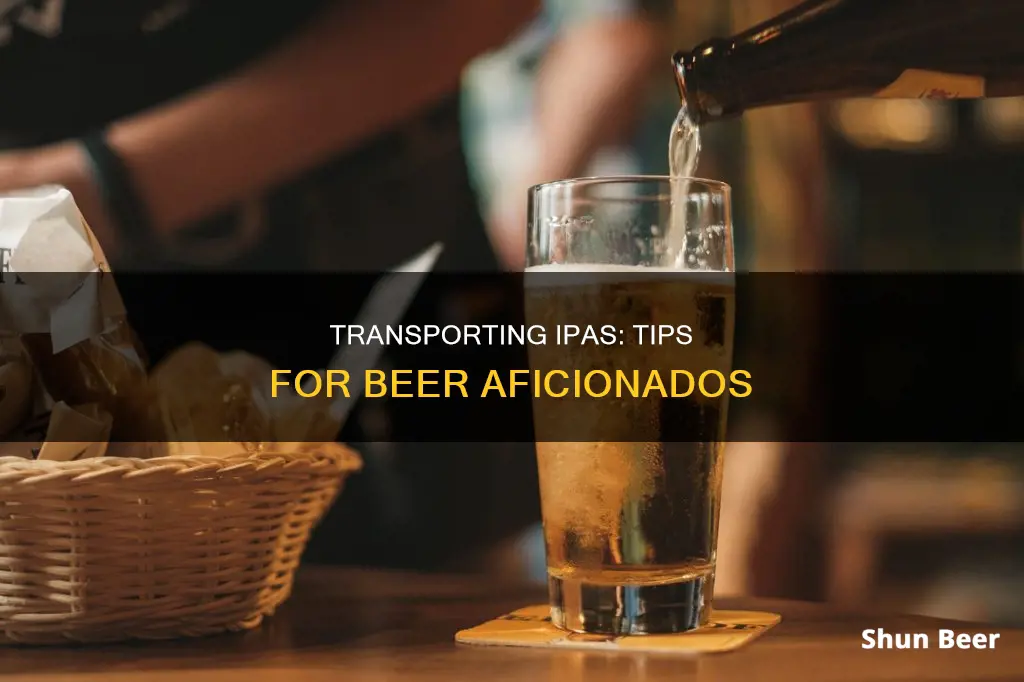
Transporting India Pale Ale (IPA) beers can be tricky due to their hoppy nature. IPAs are best served fresh, and any disturbance during transportation can affect their taste and clarity. When transporting IPAs, it is recommended to use a smooth method to avoid agitating the beer, and refrigeration before serving is often necessary to allow the beer to settle. Additionally, the choice of packaging material, such as cans or bottles, can impact the taste and shelf life of IPAs due to factors like light exposure and airtightness.
| Characteristics | Values |
|---|---|
| Container | Bottles, cans |
| Temperature | Cold |
| Time | At least a few days |
| Movement | Avoid vigorous movement |
What You'll Learn
- Transporting by bike: expect sediment to be kicked up, so allow a full day in the fridge to settle
- Transporting by car: beer may need a few more days in the fridge to settle
- Packaging: cans are better than bottles for protecting and preserving the flavour of IPAs
- Packaging: cans are also cheaper, lighter, and more easily recyclable than bottles
- Packaging: however, cans may be perceived to have an unpleasant taste

Transporting by bike: expect sediment to be kicked up, so allow a full day in the fridge to settle
Transporting beer by bike is a great way to get your brew from A to B, but it's important to remember that the journey might affect the taste and clarity of your IPA. Sediment in bottle-conditioned beers can be kicked up during transit, resulting in a cloudy appearance and a yeasty taste. To restore your beer to its former glory, simply allow it to settle in the fridge for a full day before serving. This extra time will ensure that the yeast sediment settles back out, improving both the flavour and clarity of your IPA.
When transporting beer by bike, it's inevitable that your beverage will experience some shaking and movement. This is especially true if you're navigating over bumpy terrain or taking sharp turns. The impact of this movement on your beer depends on several factors, including the type of beer, the container it's in, and the method of transport. For example, glass bottles are more susceptible to breakage and can create a bulky and fragile load.
To minimise the impact of transportation on your IPA, consider using a different type of container, such as a stainless steel growler or cans, which are less fragile and stack more easily. Additionally, invest in a good carrier that can handle the weight and provide some shock absorption, such as a backpack, panniers, or a bike-mounted beer holder. These options will help reduce the amount of shaking and potential breakage during transport.
While it's not always possible to avoid shaking your beer during transport, there are a few things you can do to minimise the impact. Firstly, try to transport your beer upright and avoid placing it in a position where it will slide around or be constantly jostled. Secondly, allow some time for the beer to settle after transportation. This can be done by letting the beer rest for at least half an hour before opening, or even better, placing it in the fridge for a full day to allow the sediment to settle completely.
By following these simple tips, you can ensure that your IPA arrives at its destination safely and tastes just as great as it did when you poured it! Remember, a little extra care in transportation and settling goes a long way towards enjoying your brew at its best.
Guinness Nitro Beer: What Are Those IBUs?
You may want to see also

Transporting by car: beer may need a few more days in the fridge to settle
Transporting beer by car may require a few extra days in the fridge to settle, especially if the beer is bottle-conditioned. Beer is best stored in a cool, dry place, with temperatures between 35 and 55 degrees Fahrenheit (2 to 13 degrees Celsius). Transporting beer by car can cause the yeast sediment to get kicked up, affecting the beer's taste and clarity. To ensure the beer is at its best, it is recommended to give it a full day or more in the fridge to settle before serving.
The ideal storage conditions for beer depend on various factors, including the type of beer, packaging, and intended serving temperature. Generally, bottled or canned beer should be stored upright in a cool, dry, and dark place. Beer is sensitive to temperature fluctuations, so it is essential to avoid exposing it to extreme temperatures during transport. Keeping the beer in a cooler or insulated bag can help maintain stable temperatures.
Additionally, the container and time of bottling can impact beer storage. For example, kegs should be stored in a cool, dry space, away from other foods, and not frozen. Packaged beer has an optimal storage temperature of 45 to 55 degrees Fahrenheit. Growlers are best stored upright in a cool, dark space and can stay fresh for several days.
Proper beer storage is crucial to maintaining the quality of the beer and preventing common issues such as spoilage and flavour deterioration. By following the recommended storage guidelines, you can ensure your beer stays fresh and tasty for longer.
Blue Moon Beer: An IPA or Not?
You may want to see also

Packaging: cans are better than bottles for protecting and preserving the flavour of IPAs
When it comes to transporting and storing IPAs, the packaging you choose can have a significant impact on preserving the flavour and quality of the beer. While bottles have traditionally been the go-to option, cans offer several advantages that make them a better choice for protecting and preserving the flavour of IPAs.
One of the main benefits of cans over bottles is their ability to block out light. Clear and green glass bottles are highly permeable to light, which can cause the beer to become lightstruck and develop an unpleasant skunky aroma. Brown bottles offer more protection, but even they can't compete with cans, which block out light completely. This is especially important for IPAs, as they are heavily hopped and more susceptible to light-induced flavour changes.
Cans also provide superior protection against oxygen ingress, which can cause oxidation and negatively impact the flavour and freshness of the beer. While both packaging options will experience some oxygen pickup during the filling process, cans generally have lower levels of total packaged oxygen (TPO) than bottles, leading to less oxidation and a longer shelf life. This is crucial for IPAs, which are meant to be consumed fresh and have a short shelf life compared to other beer styles.
In addition to light and oxygen protection, cans are also more durable and easier to transport and store than bottles. They are lighter in weight, have a more convenient shape, and don't pose the risk of broken glass. This makes them ideal for outdoor activities, such as picnics, beach trips, or camping, where broken glass could be a safety hazard.
Another advantage of cans is their lining, which helps prevent flavour contamination. Aluminium cans have a polymer lining that prevents the beer from coming into direct contact with the metal, reducing the risk of metallic flavours. This lining also acts as a barrier against outside flavours, such as those that could be introduced during transportation or storage.
While some may argue that bottles are preferable for ageing certain styles of beer, this is not typically the case for IPAs. IPAs are best enjoyed fresh, and the higher concentration of polyphenols from hops in this style actually makes them less affected by packaging. The metabolic variation between cans and bottles is minimal for IPAs, indicating that they will age similarly in either container.
Overall, when it comes to transporting and storing IPAs, cans offer superior protection against light, oxygen, and flavour contamination. They are also more durable, convenient, and environmentally friendly, making them a more sustainable option than glass bottles. By choosing cans, you can be confident that your IPAs will retain their intended flavour and freshness during transportation and storage.
Guinness Beer: Carcinogen Concerns and Consumption
You may want to see also

Packaging: cans are also cheaper, lighter, and more easily recyclable than bottles
When it comes to transporting beer, cans offer several advantages over bottles in terms of packaging. Firstly, cans are lighter than bottles, which means they require less fuel for transportation. This leads to significant fuel savings, especially when transporting beer over long distances. A truck can carry more cans than bottles, reducing the number of trips needed to deliver the same amount of beer.
Secondly, cans are more compact and stack neatly in slabs, allowing for more efficient transportation and storage. The shape of cans also means that you can fit more liquid per pallet compared to bottles due to the space taken up by the thickness of the glass and the air gap around the bottle neck.
Thirdly, cans are safer and more durable than bottles. Broken glass can be dangerous, and it is common for glass bottles to break during transportation or storage. Cans, on the other hand, are harder to damage and do not shatter, eliminating the risk of broken glass.
Additionally, cans are more easily recyclable than bottles. Aluminum cans are one of the most recycled materials globally, with a recycling rate of over 50%. They can be recycled indefinitely without losing quality, reducing waste and the use of raw materials. In contrast, glass bottles have a larger carbon footprint when it comes to transportation and require more thick cardboard packaging to ensure they don't break.
Furthermore, cans provide better protection for the beer. They block out all light and have an airtight seal, keeping the beer fresh for longer. Bottles, especially clear and green ones, let in light, which can cause chemical changes in the beer, resulting in an unpleasant taste often described as "skunky".
Guinness Beer: High Iron Content or Just a Myth?
You may want to see also

Packaging: however, cans may be perceived to have an unpleasant taste
When transporting an IPA, it is important to consider the method of transportation and the time the beer will have to settle before serving. For example, if you are transporting your beer by bike, it is likely that the yeast sediment will be disturbed, and the beer will need a full day in the fridge to settle. If you are transporting your beer by car, it is recommended that you refrigerate the bottles for a couple of weeks before transporting them and then for a few more days after to ensure that they are at their best.
One way to package your beer for transportation is to use cans. Cans are lightweight, durable, and easy to stack and store. They also provide a good barrier against light and oxygen, which can help to preserve the freshness and flavour of the beer. However, some people perceive cans to have an unpleasant taste. This could be due to a condition called dysgeusia, which is a taste disorder that can cause all foods to taste metallic, sweet, sour, or bitter. It is important to note that this perception of unpleasant taste is not a result of the can itself, but rather a condition that affects an individual's sense of taste.
To reduce the risk of dysgeusia, it is recommended to drink plenty of water, protect yourself from traumatic brain injuries and viral infections, and track your sense of taste by noting any new medications or foods in your diet. If you are experiencing dysgeusia, it is advisable to consult a healthcare professional for advice and treatment.
Another option for packaging beer is to use bottles. Bottles, especially glass bottles, can be perceived as more premium and elegant than cans. They also allow for a longer shelf life and can be preferred by beer enthusiasts for their ability to showcase the colour and clarity of the beer. However, bottles are generally more expensive than cans and are more fragile and difficult to transport and store.
When choosing a packaging material for your beer, it is important to consider the advantages and disadvantages of each option. While cans may be perceived to have an unpleasant taste by some individuals, they offer many benefits in terms of preservation, durability, and ease of transportation. Bottles, on the other hand, may be preferred for their elegance and ability to showcase the beer's appearance but come with higher costs and fragility. Ultimately, the decision should be based on the specific needs and preferences of the brewer and the target audience.
Guinness Beer: Artificial Coloring or Natural Magic?
You may want to see also
Frequently asked questions
Transporting bottled IPA beer is best done with care. The beer should be stored in a cold refrigerator and given time to settle, especially if it has been shaken up during transit. It is recommended to let the beer settle for a full day before serving.
IPA beer is best packaged in cans. Cans are more airtight than bottles, preventing skunking, and they are lighter, making them cheaper to ship. Additionally, cans allow for the beer to be poured directly onto the foam, minimising air contact, which is beneficial for IPAs due to their high hop content.
IPA beer should be stored in a cold refrigerator and served fresh. Ageing IPA beers may smooth out minor injuries incurred during fermentation, but it is generally recommended to consume them as soon as possible after purchase.
IPA beer is best served in a glass to enhance the drinking experience and allow for the appreciation of the beer's aroma.







